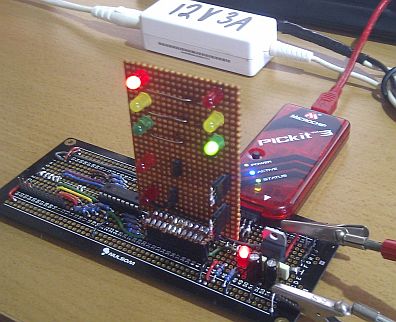

WANTED: Individual or team to take over this project. I'm in my 70's and want to put my feet up. Contact details in footer.
PIC16F88 09 TMR0IF Interrupts |
|

Polling and interrupts are two approaches to event-handling such as an input change or a timer timing out.
Polling repeatedly checks the input or timer flag to see if it has changed. This is not very efficient because the processor is tied up doing these checks. It's a bit like a house without a doorbell. You have to check the front door every minute or so to see if anyone is there.
Interrupt processing is handed over to the chip hardware so the software can get on with other tasks without having to check flags or input changes. On every instruction cycle the hardware checks the inputs or flags and if there has been a change or a flag is set, the interrupt code is called. The hardware is still polling but it takes up no time from the running program.
If an interrupt takes place, the processor suspends whatever it's doing without delay. It handles the interrupt code and finally resumes the previous task. It's like the doorbell ringing. You answer the door. Collect the package (or whatever). Then go back to what you were doing earlier.
This is usually a better way of working.
This can be run in the Simulator or in real life.
If eight LEDs are connected to PORTB, they will count in binary.
RB0 is a blur. RB2 is noticeably flickering. RB7 flashes at about 1 Hz.
The binary count is updated by the interrupt code every time TMR0 overflows.
;*******************************************************************************
; PIC16F88 Configuration Bit Settings
;*******************************************************************************
#include "p16F88.inc"
; CONFIG1 - Internal oscillator - Want I/O - Everything else turned off
__CONFIG _CONFIG1, _FOSC_INTOSCIO & _WDTE_OFF & _PWRTE_OFF & _MCLRE_OFF & _BOREN_OFF & _LVP_OFF & _CPD_OFF & _WRT_OFF & _CCPMX_RB0 & _CP_OFF
; CONFIG2 - Turn on both
__CONFIG _CONFIG2, _FCMEN_ON & _IESO_ON
;*******************************************************************************
; Uninitialised Data - Reserve bytes here ...
;*******************************************************************************
UDATA
MyCount RES 1 ; reserves 1 byte - OK with simulator debug
; MyCount EQU 0 ; FAILS with simulator debug
;*******************************************************************************
; RESET VECTOR
;*******************************************************************************
RES_VECT CODE 0x0000 ; processor reset vector
GOTO CODE_INIT ; beginning of program, initialise stuff
;*******************************************************************************
; INTERRUPT HANDLING
;*******************************************************************************
ISR CODE 0x0004 ; The interrupt vector location is always 0x0004
GOTO ISR_HANDLER ; Jump to the Interrupt handling code
;*******************************************************************************
; MAIN PROGRAM
;*******************************************************************************
MAIN_PROG CODE ; let linker place main program
CODE_INIT: ; INITIALISATION
CALL PORT_INIT ; Set up I/O Ports
CALL TIMER_INIT ; Set up Timer0
GOTO IDLE_LOOP ; Start the Idle Loop
;*******************************************************************************
; INTERRUPT SUBROUTINE
; This ought to save and restore the context
; It's not secessary in this simple example
;*******************************************************************************
ISR_HANDLER:
; INCREMENT COUNTER - UPDATE PORTS
INCF MyCount, 1 ; Increment MyCount - result into MyCount
MOVF MyCount, 0 ; Copy MyCount to WREG
MOVWF PORTA ; Copy WREG to PORTA - Remember RA5 is input only
MOVWF PORTB ; Copy WREG to PORTB
; RESTART TIMER
BCF INTCON, TMR0IF ; Remember to clear the INTCON TMR0IF flag
MOVLW d'250' ; TMR0 counts from 250 to 256 - short delay
MOVWF TMR0 ; 250 copied into TMR0
RETFIE ; Return from interrupt
;*******************************************************************************
; The Idle Loop
; MS Windows has an "idle process" which waits for the user to do something.
;*******************************************************************************
IDLE_LOOP:
NOP
NOP ; NOPs make code execution visible
NOP
NOP
GOTO IDLE_LOOP
;*******************************************************************************
; INITIALISE PORTS
;*******************************************************************************
PORT_INIT:
BSF STATUS, RP0 ; Select bank 1.
MOVLW b'00000000' ; Set all port pins to output / Disable ADC / Set for digital i/o
MOVWF ADCON1 ; Disble ADC module (Never leave this to chance)
MOVWF ANSEL ; Turn off analog i/o. Select digital i/o (Never leave this to chance)
MOVWF TRISA ; Set porta as outputs - RA5 is input only so this bit is ignored
MOVWF TRISB ; Set portb as outputs
RETURN
;*******************************************************************************
; INITIALISE TIMER0
;*******************************************************************************
TIMER_INIT:
CLRWDT ; Clear the Watchdog Timer and prescaler
MOVLW b'00000010' ; 1:8 TMR0 rate prescaling - a short delay
MOVWF OPTION_REG ; The prescaler settings are stored in OPTION_REG
BSF INTCON, GIE ; Turn on interupts globally
BSF INTCON, TMR0IE ; Turn on Timer0 interupts
BCF STATUS, RP0 ; Select bank 0.
MOVLW 0x00 ; Initialise MyCount
MOVWF MyCount ; to zero
; Start the timer for the first time
BCF INTCON, TMR0IF ; Clear the TMR0IF flag
MOVLW d'250' ; TMR0 counts from 250 to 256
MOVWF TMR0 ; 250 copied into TMR0
RETURN
END
Contact, Copyright, Cookies and Legalities: C Neil Bauers - reviseOmatic V4 - © 2016 to 2025
Hosted at Akamai Cloud - London
Please report website problems to Neil